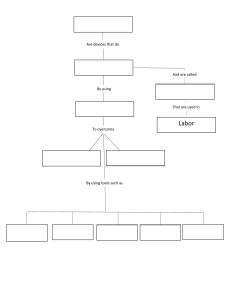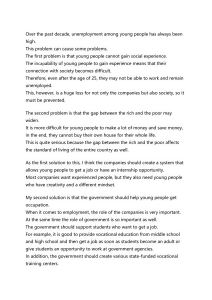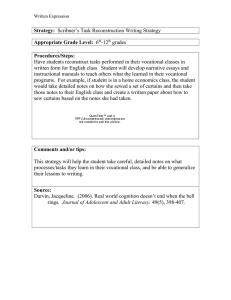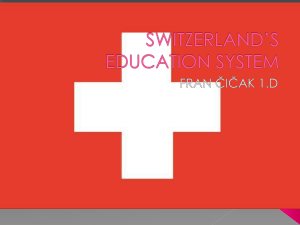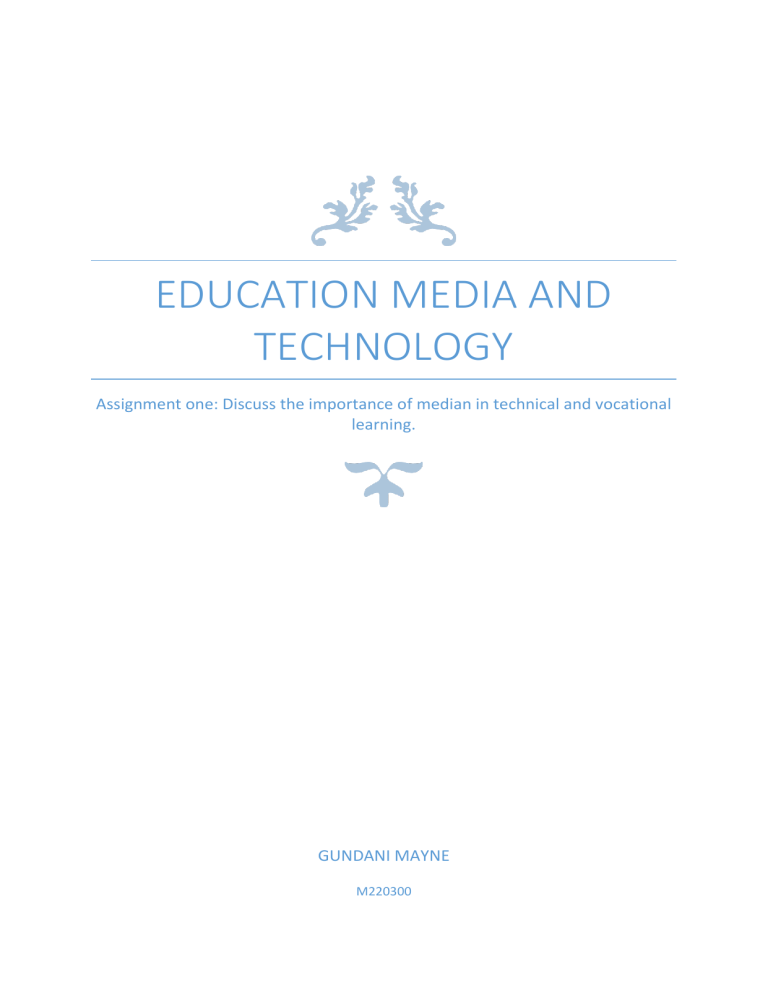
EDUCATION MEDIA AND TECHNOLOGY Assignment one: Discuss the importance of median in technical and vocational learning. GUNDANI MAYNE M220300 Discuss: The importance of media in teaching and learning of technical and vocational subject at a polytechnic. Modern day teaching has been made better by innovations introduced to underdeveloped countries by developed countries. The innovations started from the provision of paper and ink to make records of learning easier. More technology has been made and now learning is becoming paperless with the provision of electronic equipment like computers. This type of media has made the learning process standardised and interactive. Media has made learning motivating, has overcome socio-economic barriers and also overcome the limitations of space and time. This essay is going to show why it is important for media to overcome these limitations and motivate students in technical and vocational colleges. The term media is a plural of the word medium. It is infrequently used because a lecturer at a polytechnic college never uses one medium for concept elaboration. Lecturers often use gestures, amplified voices and whiteboards to clarify points. The term medium can be referred to as a tool, material, vehicle, channel, aid, gadget, instrument and device among others (Mukandi , Pisirai, & Chindedza , 2020). There are two types of media, that is projected and non-projected media. Projected media needs power to work for example smartphones, computers and projectors. Non projected media include charts, posters, work-card and molyclad models. (Romiszowski, 1998) has grouped roles of media into two. Firstly, media is used as instructional aids. These aids are used to enhance a lecturer’s presentation. Media used in this way are one way transmitters and cannot interpret the messages that the learner transmits. Media can also be used as instructional systems. These promote individualisation of instruction in both conventional and non-conventional setting. The example is e-learning (Shabiralyani, Shahzad, Hamad, & Iqbal, 2015) believe that people remember 90% of what they say as they do. This shows that media in visual learning is important and in technical and vocational training helps learners to use more than one sense and greater rewards are reaped. Vocational and technical education is a term used to refer to all educational processes that involve general teaching and learning of technologies and sciences, skills and knowledge relating to occupations in different industrial sectors (Ekpenyong, 2005). The technical education is offered at the upper secondary level, polytechnics to prepare students for universities and higher national diplomas. They are prepared to be engineers and business people. Aim of technical education is to equip individuals to use their heads and related skills to survive. Firstly, media standardises the delivery of learning materials. To standardise is to make things of the same type have the same specific features (Dr Latta, 2022). In technical and vocational training, the way information is shared and how deeply it is understood can be standardised using media. Molyclad models used in chemistry are the same in many laboratories. Using these models, helps lecturers share knowledge in the same manner. They will have the same interpretation of a concept. Standardisation also assumes that if every individual is exposed to the same set of instructional conditions, all the students will have the same knowledge. A student taking chemistry courses at Kwekwe polytechnic college and one taking the same course at Harare polytechnic college will have the same knowledge because of standardisation. Having a set of standards helps protect the understanding of individuals (Dr Latta, 2022). (Bjered, 2013) breaks down the elements of public education that are standardised. These include pace, level and path of learning. They also include curriculum, assessments, expectations and level of digital access. Using media to standardise lesson delivery therefore is important in all aspects of learning at a polytechnic. Media has been proven to be important because it makes the learning process become more interactive. (Amidon, 1967) defined teaching as an interactive process involving classroom talk which takes place between teacher and pupil and occurs during certain definable activities. In interactive learning the student is a participant and is expected to perform certain actions for example helping setting up models and apparatus in chemistry. The student then basically appears to actually be the driving force behind all that is happening. Students when personally contributing to common cause they gain new knowledge through organising collective activities. Interaction between student and lecturer is at par and there is no dominance of lecture in the process (Bakytgul, Samal, Shynar, Zhanagul, & Zhanylsn, 2016). If there is no dominance in learning, the student and lecturer in technical and vocational training have continual communication. Interactive learning helps establish a friendly atmosphere among participants and have them connect with each other. This boost self-reliance and self-assurance and thus reduce workload on the lecturer. In technical and vocational training in Africa, this removes the fear of language barriers and students can communicate with each other using vernacular language to explain different concepts found in their learning. In interactive learning students can be left with a power point presentation to teach each other using a projector, that is self-reliance. The presentations they do are said to be based on information communication technology (ICT) This media is important in technical and vocational learning of chemistry subjects as it shows how different experiments are done on schematic diagrams that may be impossible because lack of apparatus in the laboratories. Another importance of media in teaching and learning at technical and vocational colleges is that it increases motivation. (Dubin, 1974) defines motivation as something that moves a person to action and continues him in the course of action already initiated. Motivation can be divided into two, intrinsic (derived from the student itself) and extrinsic (that comes from outside student self). These types of motivation need to be boosted using media. Learning media that is appropriately used in the learning process will become more effective and efficient. It will help in achieving learning objectives (Puspitarini & Hanif, 2019). The benefits of media include making a lecture more interesting and thus motivates the students’ learning. Using textbooks only is called a didactic method of lecturing. Using different methods like podcasts and projectors motivates students by engaging them in the learning process using familiar instructional tools that improve self-efficacy and self-worth. Instructional videos can be a media used to motivate students. These are important because students see and imagine the real and contextual material. This is backed up by a study done by (Ismail, Irwan, Othman, Amiruddin, & Arriffin, 2017). He found out that video based instruction was more memorable than traditional text based instruction. This motivated students. Media is also important in learning because it can overcome the socio-cultural barriers between students with different customs, habits, environments and experiences. Sociocultural barriers are man-made constructs originating from social norms and cultural values. They mainly have adverse effects on information sources and give rise to negative emotions (Savolainen, 2016). There different types of socio-cultural barriers and these include language, social stigma and cultural taboo, organisational barriers and barriers due to lack of social economic capital (Zaw, 2018). In language as a socio-cultural barrier, media can be used to translate video lectures made in foreign languages and they can be subtitled. For chemistry courses in technical and vocational learning, some equipment may not be found at schools, but with video lectures made by developed countries, learners can learn concepts better. Social stigma and cultural taboos are barriers found in countries where women are not allowed to attain higher education. In Afghanistan, women have been barred from entering institutions of higher learning (Humaira, 2021). These women can attain a certificate online from universities that offer them. This needs media like internet and electronic equipment. Other problems of social stigma are faced by people who enrol late after having taking care of the family. Using media, these people can familiarise themselves with technical courses that suit their passion before enrolling. Failure to that may cause them to choose courses that are against what they want to do in life. Other socio economic barriers are organisational and cause students to be overwhelmed with work when learning. Information from lectures may be put in simple formats that help trainees absorb the information faster. Lack of economic capital is another barrier that can be overcome by media. Students who cannot afford electronic equipment may have lecture notes printed and these can be read clearly. The above data clearly shows how media is important in technical and vocational training because one can overcome socio economic barriers using it. Another way in which media is important in learning is overcoming the limitations of space, time. Limitations are weaknesses within learning which influence the outcomes and conclusions of research (Greener, 2018). To overcome the limitations of space, media can be used to show diagrams and schematics of how complicated processes done in lecturing chemistry in technical and vocational training. An example of this is the schematics of machinery and equipment used in water purification at Gweru City Council. The process is huge and cannot be fit in a classroom. If students are provided with videos and schematics, they can learn the process in real time. Media can also be used to overcome the limitations of time. Some plants where processes learnt in chemistry are done are located away from technical colleges. An example is BOC gases located in Harare where liquid purification of air to provide pure oxygen used in hospitals is done. Instead of spending time and other resources visiting these companies, video lectures of the processes done can be sent to students so they learn in real time. Thus media is important in learning. In summary, one could say media has advanced learning. It has helped bring the whole world to the lecture room. This in turn has made learning more interesting. When learning is interesting students are motivated to learn more. Since media has overcome socio-economic barriers, this has given a chance to people of all races to and languages to learn anything and be taught by lecturers who do not even speak their language and are located in other countries. Media has also overcome the limitations of space and time and thus students can learn all processes as if they were in industries where these processes are done. References Amidon, E. J. (1967). The Role of the Teacher in the Classroom: A manual for understanding and improving teacher's classroom behaviour. Association for Productive Teaching. Bakytgul, A., Samal, N., Shynar, Y., Zhanagul, K., & Zhanylsn, S. (2016). The Use of Interactive Learning Technology in Instititutions of Higher Learning. International Jiurnal of Enviromental Science and Education, 11(18), 12528-12539. Bjered, M. (2013). Education Standadisation: essential or Harmful. Dr Latta, L. (2022, May 14 May 2022). Equity in education: Defining Equity, Equality, and Standardisation. Retrieved from Impact Tulsa: https://wwww.impacttulsa.org/2019/11/26impacttulsa-equity-in-education-defining-equity/ Dubin, R. (1974). Human Relations Adminstartion. Englewood Cliffs, N. J. Prentice Hall, 124-125. Ekpenyong, L. E. (2005). Foundations of technical and vocational education. New Directions and Approaches. Greener, S. (2018). Research Conditions: The need for Honesty and Common Sense. 10, 567-568. Humaira, H. (2021). The Education of women in Afghanistan. Retrieved May 14, 2022 Ismail, M. E., Irwan, M. I., Othman, H., Amiruddin, M. H., & Arriffin, A. (2017). The Us of animation video to enhance the Imagination and Visualisation of Student in Engineering Drawing. IOP Conference Series: Materials Science and Engineering, 203, pp. 1-1. Retrieved May !4, 2022 Mukandi , C., Pisirai, C., & Chindedza , W. (2020). The Role of instructional media and technology in the zimbabwean primary school curriculum. international journal of research and innovation in social science (IJRISS), 4(6), 2454-6. Puspitarini, Y. D., & Hanif, M. (2019). Using Learning Media to Inccease Learning Motivation in elementary school Leraning. Annotation Journal of education, 4(2), 53-60. Romiszowski, A. J. (1998). the selection and use of instructional meida. london: Kogan. Savolainen, R. (2016). Approaches to Socio-Economic barriers to information seeking. Library and Information Science Research, 38(1). Shabiralyani, G., Shahzad, K., Hamad, N., & Iqbal, N. (2015). Impact of Visual Aids in Enhancing the Learning Process Case Reasearch. Journal of Education and Practise, 6(19), 226-233. Zaw, H. (2018). The Impact of scial Media on cultural adaptation process: Study on the Chinese Government Scholarship students. Advances in Journalism and Communication, 6, 75-89.
